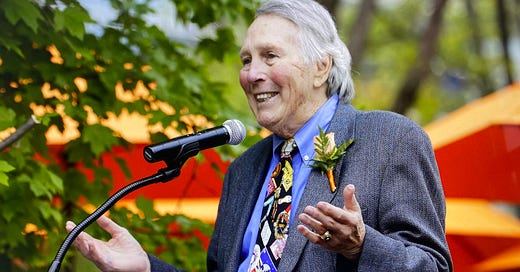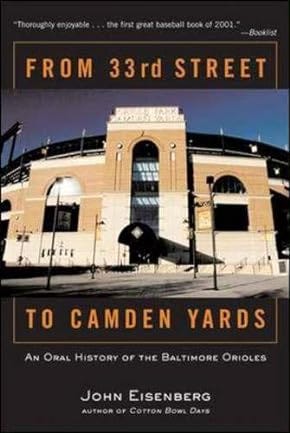My Hall of Fame Fact-Checker
When Brooks Robinson passed away last year at age 86, it seemed everyone had a story about their interactions with him. This is mine.
During my many years of writing books, columns and articles about baseball and other sports, I’ve worked with dozens of copy editors.
Only one is enshrined in the baseball Hall of Fame.
Years ago, after I finished interviewing Brooks Robinson for From 33rd Street to Camden Yards, my oral history of the Orioles, he wound up becoming the most famous person who ever fact-checked any of my work.
“You know,” Brooks told me as our interview concluded in the spring of 2000, “I think I’ve seen everyone who ever played for the Orioles. I’ve watched them all play.”
It was quite a statement. We were in the year 2000. The Orioles had played in the American League since 1954.
Forty-six years of baseball and he had seen … everyone?
When I expressed wonderment, he said, “Well, I was on the team forever and then I did the games on TV and now I still follow the team and see guys around town.
“So, yeah, I think I’ve seen them all.”
He had signed with the Orioles in 1955, their second year of existence, and hundreds of players had worn the uniform since then, but sure enough, one way or another, he’d seen them all and knew most of them.
Talk about institutional knowledge.
During our interview we’d gone deep into the weeds of Oriole history, discussing such long-forgotten players as Connie Johnson, a pitcher who was among the Orioles’ first Black players; Clint “Scrap Iron” Courtney, a catcher with quirks, to put it mildly; and George Zuverink, one of the game’s first relief pitchers.
“Did you get ahold of him?” Brooks would ask when a name came up.
When I said I did, he smiled.
“If you’d like,” he said after our interview concluded, “you can give me your manuscript when you’re done and I can take it and read it and see if anything needs to be fixed, maybe a name, an incident, spelling, who knows? I’d be happy to do that.”
I don’t think I’ve ever accepted an offer faster.
From John Eisenberg: Introducing the Bird Tapes
When I completed a primary draft of the manuscript a few months later, I called him and we arranged to meet. His eyes widened as I handed him a thick stack of 800 or so typewritten pages.
“I guess you can’t sum up 46 years of baseball in a few pages,” he chuckled. “But I’m looking forward to reading it.”
It was a testament to his down-to-earth nature that I really didn’t think anything of it. I’d been in the Baltimore media contingent with him when he was broadcasting the games. Nothing breaks down social barriers faster than sharing a tasty pregame meal in the press box in Detroit.
Years later, I’m far more wondrous about what he did. Six weeks after I handed him the manuscript, he called me at home.
One of my kids picked up. “This is Brooks Robinson calling. Is your dad there?” he said.
The life of a sportswriter back in the day.
He passed along a list of corrections and impressions – a dozen or so places where I’d either misspelled a name or, in his mind, not given a particular person or incident enough attention.
I wrote it all down. I can’t remember how I headlined his list but this was it in a nutshell: Input from my copy editor enshrined in the Hall of Fame.
“It’s just a few little things, really,” Brooks said. “Hey, I loved it. I don’t think I’ve ever read a history of the Orioles like that.”
Needless to say, his reaction eased my inevitable nonfiction author’s qualms about “getting it right.” The book was published months later with a glowing blurb from Brooks on the back cover: “From 33rd Street to Camden Yards is a wonderful book from the people who lived it. A most nostalgic read for Orioles fans.”
I’m flattered to say the experience moved him, or so it seemed. A decade later, on the day his statue was unveiled at Oriole Park at Camden Yards, he mentioned me and my book in his speech.
“You know I’ve been thinking about how long that I was with the Baltimore Orioles as a player and how long I’ve been in Baltimore. And as you know, the Orioles came to town in 1954, and I signed with the Orioles in 1955. I think it was John Eisenberg, a sports columnist with the Baltimore paper, maybe just freelanced around, but he wrote a book about the history of the Orioles. In reading John’s book, I found out that I’ve seen every Oriole player in the history of the Orioles. And that goes back for a lot of memories, there’s only about four or five players that I did not see in a uniform. So you see I do have a lot of wonderful memories.”
I was not at the ballpark. It was a Saturday afternoon and I was at the movies.
When I checked my phone as I left the theater, I had about 200 texts and voice messages. It took me a few minutes to decipher what had happened.
A shout-out from Brooks before a packed house at the ballpark.
One of my favorite memories.
There certainly is no better way for me to begin The Bird Tapes, my new Substack publication about the history of the Orioles, than by posting my interview with Brooks from a quarter-century ago. Having listened to it again all these years later, I’m delighted to report that it captures his singular essence that so many people in Baltimore experienced before he passed away last year at age 86. In this interview, he’s in his early 60s, sharp, incisive, personable, relatable, funny.
He is the Brooks Robinson who read 800 manuscript pages and called me with corrections.
I’ll post the interview on Monday.







No better way to lead off Bird Tapes than with this story about Brooks, the most beloved Bird of them all.